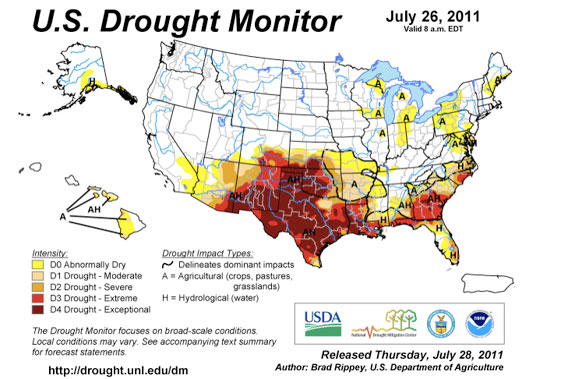
Map shows the level of drought and dryness across the US in July 2011. Map courtesy US Department of Agriculture. Click to enlarge.
A punishing drought in Texas has not only damaged crops, killed cattle, and led to widespread fires, but has also killed off a significant portion of the state’s trees: between 100 and 500 million trees have perished to drought stress according to preliminary analysis. The estimate does not include tree mortality caused by fires. The drought has been linked to La Niña conditions, which causes drying in the Southern U.S., and has likely been exacerbated by global climate change.
In all around 10 percent of Texas’ forests may have been lost to the drought—so far. Trees are expected to continue suffering and dying in Texas even if rain comes, however forecasters predict dry conditions will remain in Texas for another six months at least.
“This is a generational event,” Barry Ward, executive director of Trees for Houston told Reuters. “Mature trees take 20 or 30 years to re-grow. This will make an aesthetic difference for decades to come.”
A recent study looking at tree ring data found that Texas had not seen a drought of this magnitude since 1789 when the territory was contested between the Spanish and Native Americans.
“[The drought] is basically off the charts. Based on past history, you wouldn’t expect to see this happening in maybe 500 or 1,000 years. One more year and we’re already talking about a drought more severe than anything we’ve ever had,” Texas state climatologist, John Nielsen-Gammon, told CBS at the time.
A report in 2009 on expected climate change impacts in the Southwest region of the U.S. predicted increased drought and wildfires with negative impacts on agriculture and forests. Scientists say droughts like Texas’ are increasingly becoming a combination of both natural variance and human impact, i.e. climate change.
“When a drought comes, often temperatures are already higher than they would have been 50 years ago and so the effects of the drought are magnified by higher evaporation rates,” Texas climatologist Katherine Hayhoe explained to Climate Progress.
Related articles
Another record breaker: 2011 warmest La Niña year ever
(11/30/2011) As officials meet at the 17th UN Climate Summit in Durban, South Africa, the world continues to heat up. The UN World Meteorological Organization (WMO) has announced that they expect 2011 to be the warmest La Niña year since record keeping began in 1850. The opposite of El Nino, a La Niña event causes general cooling in global temperatures.
Current emission pledges will raise temperature 3.5 degrees Celsius
(12/06/2011) New research announced at the 17th UN Climate Summit in Durban, South Africa finds that under current pledges for reducing emissions the global temperature will rise by 3.5 degrees Celsius (6.3 degrees Fahrenheit) from historic levels, reports the AFP. This is nearly double world nations’ pledge to keep warming below 2 degrees Celsius (3.6 degrees Fahrenheit). The report flies in the face of recent arguments by the U.S. and others at Durban that current pledges are adequate through 2020.
Global carbon emissions rise 49 percent since 1990

(12/04/2011) Total carbon emissions for the first time hit 10 billion metric tons (36.7 billion tons of CO2) in 2010, according to new analysis published by the Global Carbon Project (GCP) in Nature Climate Change. In the past two decades (since the reference year for the Kyoto Protocol: 1990), emissions have risen an astounding 49 percent. Released as officials from 190 countries meet in Durban, South Africa for the 17th UN Summit on Climate Change to discuss the future of international efforts on climate change, the study is just the latest to argue a growing urgency for slashing emissions in the face of rising extreme weather incidents and vanishing polar sea ice, among other impacts.